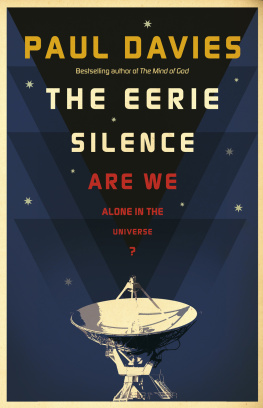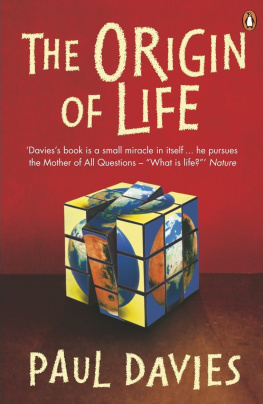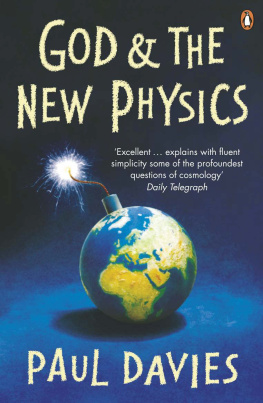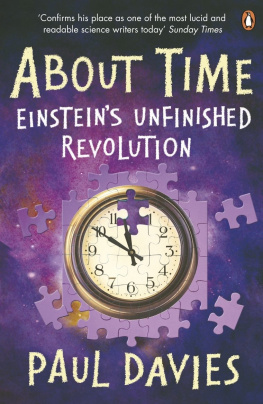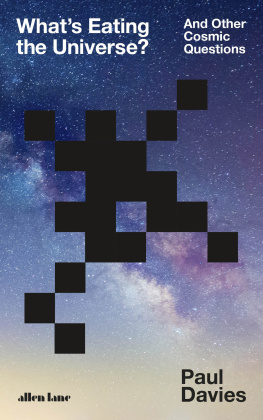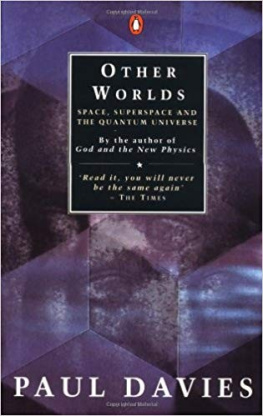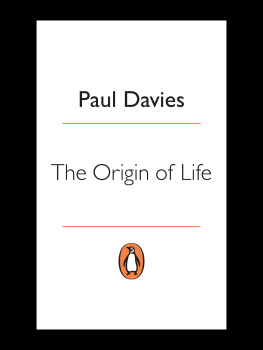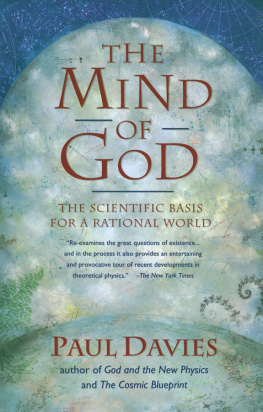Paul Davies - The Eerie Silence: Are We Alone in the Universe?
Here you can read online Paul Davies - The Eerie Silence: Are We Alone in the Universe? full text of the book (entire story) in english for free. Download pdf and epub, get meaning, cover and reviews about this ebook. year: 2010, publisher: Allen Lane, genre: Religion. Description of the work, (preface) as well as reviews are available. Best literature library LitArk.com created for fans of good reading and offers a wide selection of genres:
Romance novel
Science fiction
Adventure
Detective
Science
History
Home and family
Prose
Art
Politics
Computer
Non-fiction
Religion
Business
Children
Humor
Choose a favorite category and find really read worthwhile books. Enjoy immersion in the world of imagination, feel the emotions of the characters or learn something new for yourself, make an fascinating discovery.
- Book:The Eerie Silence: Are We Alone in the Universe?
- Author:
- Publisher:Allen Lane
- Genre:
- Year:2010
- Rating:4 / 5
- Favourites:Add to favourites
- Your mark:
- 80
- 1
- 2
- 3
- 4
- 5
The Eerie Silence: Are We Alone in the Universe?: summary, description and annotation
We offer to read an annotation, description, summary or preface (depends on what the author of the book "The Eerie Silence: Are We Alone in the Universe?" wrote himself). If you haven't found the necessary information about the book — write in the comments, we will try to find it.
The Eerie Silence: Are We Alone in the Universe? — read online for free the complete book (whole text) full work
Below is the text of the book, divided by pages. System saving the place of the last page read, allows you to conveniently read the book "The Eerie Silence: Are We Alone in the Universe?" online for free, without having to search again every time where you left off. Put a bookmark, and you can go to the page where you finished reading at any time.
Font size:
Interval:
Bookmark:
PAUL DAVIES
Are We Alone in the Universe?

ALLEN LANE
an imprint of
PENGUIN BOOKS
To Frank Drake
SETI pioneer and tireless visionary
ALLEN LANE
Published by the Penguin Group
Penguin Books Ltd, 80 Strand, London WC2R 0RL , England
Penguin Group (USA) Inc., 375 Hudson Street, New York, New York 10014, USA
Penguin Group (Canada), 90 Eglinton Avenue East, Suite 700, Toronto, Ontario, Canada M4P 2Y3
(a division of Pearson Penguin Canada Inc.)
Penguin Ireland, 25 St Stephens Green, Dublin 2, Ireland (a division of Penguin Books Ltd)
Penguin Group (Australia), 250 Camberwell Road, Camberwell, Victoria 3124, Australia
(a division of Pearson Australia Group Pty Ltd)
Penguin Books India Pvt Ltd, 11 Community Centre, Panchsheel Park, New Delhi 110 017, India
Penguin Group (NZ), 67 Apollo Drive, Rosedale, North Shore 0632, New Zealand
(a division of Pearson New Zealand Ltd)
Penguin Books (South Africa) (Pty) Ltd, 24 Sturdee Avenue, Rosebank, Johannesburg 2196, South Africa
Penguin Books Ltd, Registered Offices: 80 Strand, London WC2R 0RL , England
www.penguin.com
First published 2010
Copyright Paul Davies, 2010
The moral right of the author has been asserted
All rights reserved.
Without limiting the rights under copyright reserved above, no part of this publication may be reproduced, stored in or introduced into a retrieval system, or transmitted, in any form or by any means (electronic, mechanical, photocopying, recording or otherwise) without the prior written permission of both the copyright owner and the above publisher of this book.
ISBN: 978-0-14-194405-0
Sometimes I think were alone in the universe, and sometimes I think were not. In either case the idea is quite staggering.
Arthur C. Clarke
In August 1931, Karl Jansky, a radio engineer working for Bell Telephone Laboratories in Holmdel, New Jersey, serendipitously made a major scientific discovery. Jansky had been assigned the task of investigating annoying radio static that interfered with transatlantic telephony. To check it, he built a simple antenna from metal struts, mounted on four car tyres so it could rotate, and proceeded to monitor radio noise from different directions. The output of the ramshackle instrument was a pen and ink recorder. Jansky was soon detecting thunderstorms, even far away, but he was puzzled by a background hiss that seemed to display a 24-hour cycle. Intrigued, he looked more closely and found the period to be 23 hours and 56 minutes, the duration known to astronomers as the sidereal day the time it takes for Earth to rotate once relative to the distant stars (as opposed to the solar day, the time it takes to rotate relative to the sun). The sidereal periodicity implied that the radio source lay far out in space. Jansky eventually concluded that the radio static emanated from the Milky Way. Before he could follow up on it, however, he was assigned other duties by the company.
In this curiously low-key manner, an entire scientific discipline radio astronomy was born. No fanfare, no medals. Further progress came, as so often in science, with war. The development of radar during the Second World War greatly boosted the power and fidelity of radio receivers, and in the immediate post-war years, physicists and astronomers spotted an opportunity. Using cheap left-over wartime equipment, they began to build the first proper radio telescopes, enormous dishes that enabled them to tune into the universe. About this time, in the 1950s, it dawned on some scientists that radio telescopes were powerful enough to communicate across interstellar distances, so that if there The following year, the challenge was taken up by a young astronomer, Frank Drake, to whom this book is dedicated. Drake used a radio telescope in West Virginia to begin searching for alien radio signals, and from his pioneering project the international research programme known as SETI was born. SETI stands for Search for Extraterrestrial Intelligence, and since the 1960s a heroic band of radio astronomers have been scouring the skies for any sign that we are not alone in the universe. In 2010, SETI will be officially fifty years old, which seems a good time to take stock. This book is a tribute to the dedication, professionalism and infectious optimism of SETI researchers in general, and to Frank Drakes courage and vision in particular.
The subject of SETI is speculative to a degree far beyond that of conventional science. It is wise to take any discussion of alien civilizations with a very large dose of salt. But retaining a robust scepticism need not prevent us from approaching SETI in a methodical and penetrating way, informed by the very best science we have. That is the spirit in which I have written this book. I have taken care to separate facts and theories in which we have some confidence, from reasonable but untested extrapolation, and from wilder speculation driven largely by ideas from science fiction.
I was still a high school student when SETI began, and although I was vaguely aware of it, my understanding of life beyond Earth was gleaned almost entirely from science fiction. Like many people, I learned more about SETI from the many television appearances of the charismatic scientist Carl Sagan, whose novel Contact, and the subsequent Hollywood movie based on it, convinced many people that SETI is a human adventure without parallel. In my later years, I came to know the key players quite well, many of whom now work at the SETI Institute in California. Much of what I have written about in this book stems from my long and fruitful association with them, especially Frank Drake, Jill Tarter, Seth Shostak and Doug Vakoch.
I didnt just want to write a bland congratulatory book. Instead, I decided to take a penetrating look at the aims and assumptions of the entire enterprise. As I wrote it, I kept asking whether we might not be missing something important. Old habits of thought die hard, and a project that has been running for fifty years can benefit from a shake-up. In February 2008 I held a workshop at Arizona State University called The Sound of Silence to encourage radically new ways of addressing the evocative question Are we alone? The contents of this book reflect much of our discussion at the workshop, and my thanks are due to all the participants.
There are some special acknowledgements I should like to make. First and foremost is my wife Pauline Davies, a science journalist and broadcaster with a deeply sceptical mind, and an uncompromising stickler for factual accuracy and properly reasoned argument. She not only pounced on many a slip, but helped me clarify a lot of the arguments, and contributed several ideas of her own which appear without specific attribution in the text. My views on the subject have been greatly shaped by the many in-depth discussions she and I have had over several years. Carol Oliver, former journalist, SETI scientist and now astrobiologist, has been a valued colleague and supporter during my SETI career. Gregory Benford, James Benford, David Brin, Gil Levin and Charles Lineweaver gave good critical feedback on some sections of the book. My literary agent John Brockman has been a decades-long source of encouragement and support for my writing career. My editors Amanda Cook and Will Goodlad have shepherded the project with skill and sympathy; the text is greatly improved as a result of Amandas detailed critique. And finally, a huge thank you to Frank Drake himself, whose inspirational lectures and articles got me into this field in the first place.
Next pageFont size:
Interval:
Bookmark:
Similar books «The Eerie Silence: Are We Alone in the Universe?»
Look at similar books to The Eerie Silence: Are We Alone in the Universe?. We have selected literature similar in name and meaning in the hope of providing readers with more options to find new, interesting, not yet read works.
Discussion, reviews of the book The Eerie Silence: Are We Alone in the Universe? and just readers' own opinions. Leave your comments, write what you think about the work, its meaning or the main characters. Specify what exactly you liked and what you didn't like, and why you think so.

